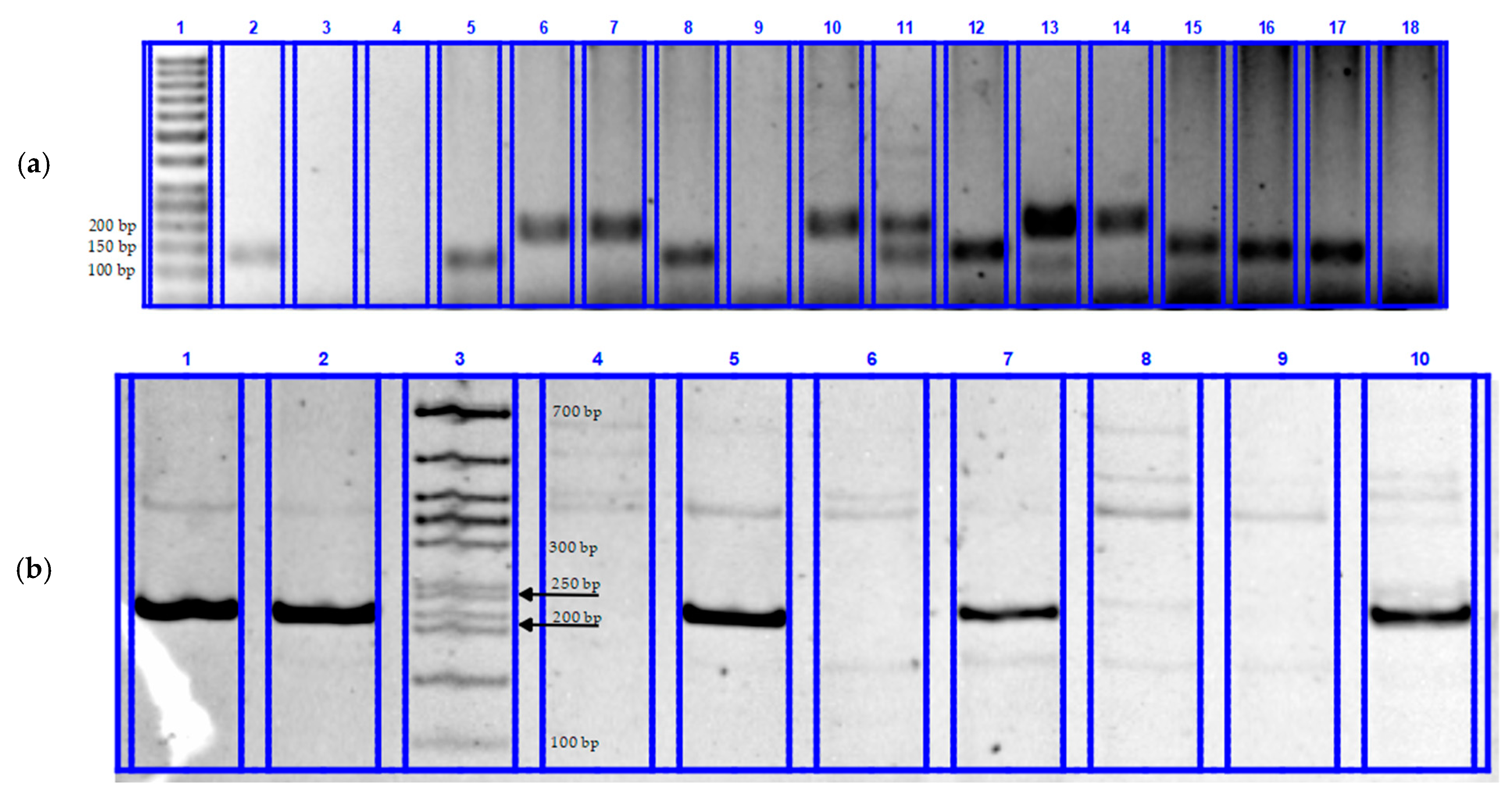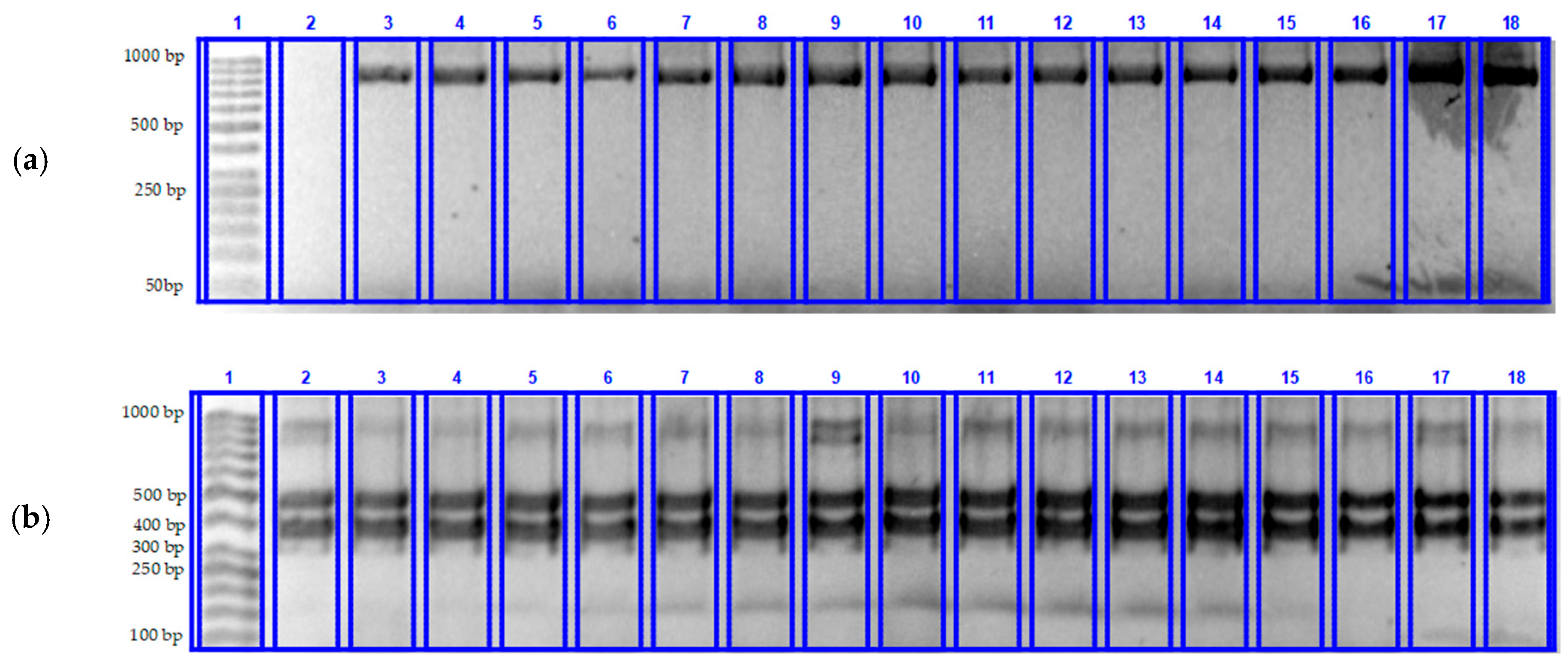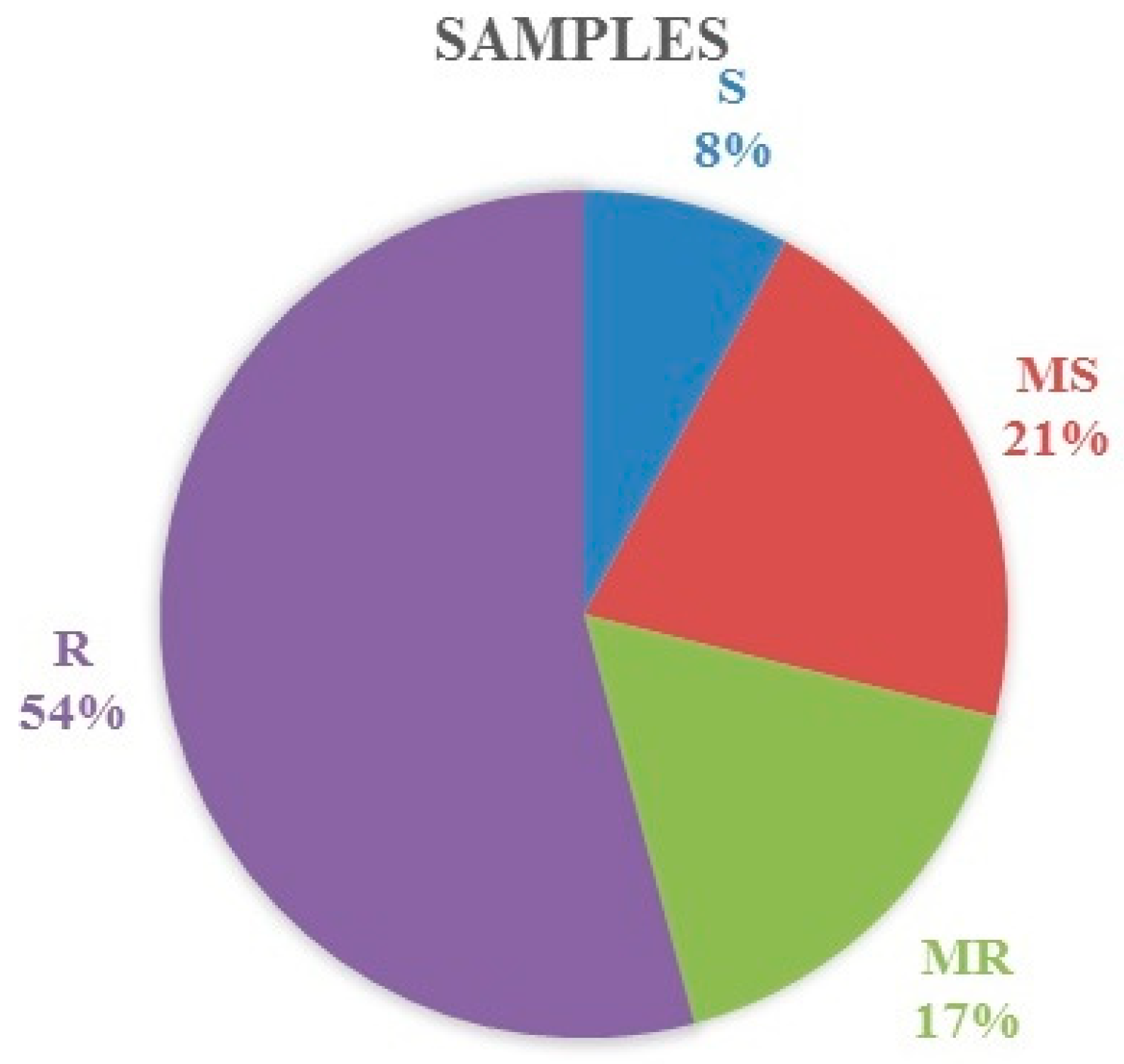Identification of Stem Rust Resistance Genes in the Winter Wheat Collection from Southern Russia
Abstract
1. Introduction
2. Results
3. Discussion
4. Materials and Methods
4.1. Plant Material
4.2. Field Test
4.3. DNA Extraction and Study
4.4. Data Analysis
Supplementary Materials
Author Contributions
Funding
Acknowledgments
Conflicts of Interest
References
- Shewry, P.; Hey, S. The contribution of wheat to human diet and health. Food Energy Secur. 2015, 4, 178–202. [Google Scholar] [CrossRef]
- Vyska, M.; Cunniffe, N.; Gilligan, C. Trade-off between disease resistance and crop yield: A landscape-scale mathematical modelling perspective. J. R. Soc. Interface 2016, 13, 20160451. [Google Scholar] [CrossRef] [PubMed]
- Lewis, C.; Persoons, A.; Bebber, D.; Kigathi, R.; Maintz, J.; Findlay, K.; Bueno-Sancho, V.; Corredor-Moreno, P.; Harrington, S.; Kangara, N.; et al. Potential for re-emergence of wheat stem rust in the United Kingdom. Commun. Biol. 2018, 1, s42003–s42018. [Google Scholar] [CrossRef] [PubMed]
- Pretorius, Z.A.; Singh, R.P.; Wagoire, W.W.; Payne, T.S. Detection of virulence to wheat stem rust resistance gene Sr31 in Puccinia graminis f. sp. Tritici in Uganda. Plant Dis. 2000, 84, 203. [Google Scholar] [CrossRef] [PubMed]
- Soko, T.; Bender, C.; Prins, R.; Pretorius, Z. Yield Loss Associated with Different Levels of Stem Rust Resistance in Bread Wheat. Plant Dis. 2018, 102, 2531–2538. [Google Scholar] [CrossRef] [PubMed]
- Management of Wheat and Barley Diseases. Available online: https://books.google.ru/books?id=xKU5DwAAQBAJ (accessed on 25 September 2019).
- Terefe, T.; Visser, B.; Pretorius, Z. Variation in Puccinia graminis f. sp tritici detected on wheat and triticale in South Africa from 2009 to 2013. Crop Prot. 2016, 86, 9–16. [Google Scholar] [CrossRef]
- Boshoff, W.H.P.; Pretorius, Z.A.; Van Niekerk, B.D.; Komen, J.S. First report of virulence in Puccinia graminis f. sp. tritici to wheat stem rust resistance genes Sr8b and Sr38 in South Africa. Plant Dis. 2002, 86, 922. [Google Scholar] [CrossRef]
- Sibikeev, S.N.; Markelova, T.S.; Baukenova, E.A.; Druzhin, A.E. Likely threat of the spread of race UG99 of Puccinia graminis f. sp. tritici on wheat in Southeastern Russia. Russ. Agric. Sci. 2016, 42, 145–148. [Google Scholar] [CrossRef]
- Yadav, P.; Mishra, V.; Arun, B.; Chand, R.; Vishwakarma, M.; Vasistha, N.; Mishra, A.; Kalappanavar, I.; Joshi, A. Enhanced resistance in wheat against stem rust achieved by marker assisted backcrossing involving three independent Sr genes. Curr. Plant Biol. 2015, 2, 25–33. [Google Scholar] [CrossRef]
- Singh, R.; Hodson, D.; Huerta-Espino, J.; Jin, Y.; Njau, P.; Wanyera, R.; Herrera-Foessel, S.; Ward, R.; Sparks, D. Will stem rust destroy the world’s wheat crop? Adv. Agron. 2008, 98, 271–309. [Google Scholar] [CrossRef]
- Xu, X.; Yuan, D.; Li, D.; Gao, Y.; Wang, Z.; Liu, Y.; Wang, S.; Xuan, Y.; Zhao, H.; Li, T.; et al. Identification of stem rust resistance genes in wheat cultivars in China using molecular markers. PeerJ 2018, 6, e4882. [Google Scholar] [CrossRef] [PubMed]
- Xu, X.; Li, D.; Liu, Y.; Gao, Y.; Wang, Z.; Ma, Y.; Yang, S.; Cao, Y.; Xuan, Y.; Li, T. Evaluation and identification of stem rust resistance genes Sr2, Sr24, Sr25, Sr26, Sr31 and Sr38 in wheat lines from Gansu Province in China. PeerJ 2017, 5, e4146. [Google Scholar] [CrossRef] [PubMed]
- Volkova, G.V.; Sinyak, E.V. Stem rust of wheat. Prot. Quar. Plants 2011, 11, 14–16. [Google Scholar]
- Miroshnichenko, O.O.; Volkova, G.V. Efficacy of the known genes of resistance (Sr) to wheat stem rust (pathogene Puccinia graminis pers.) in the south of Russia. In Proceedings of the Biologicheskaya zashchita rastenii–osnova stabilizatsii agroekosistem: Mater. Mezhdunar. nauch.prakt. konf (Biological Protection of Plants is the Basis of the Stabilization of AgroEco systems: Proc. Int. Sci.Pract. Conf.), Krasnodar, Russia, 11–13 September 2018; pp. 358–360. [Google Scholar]
- Yu, L.; Barbier, H.; Rouse, M.; Singh, S.; Singh, R.; Bhavani, S.; Huerta-Espino, J.; Sorrells, M. A consensus map for Ug99 stem rust resistance loci in wheat. Theor. Appl. Genet. 2014, 127, 1561–1581. [Google Scholar] [CrossRef] [PubMed]
- Hare, R.A.; McIntosh, R.A. Genetic and cytogenetic studies of durable adult plant resistances in Hope and related cultivars to wheat rusts. J. Plant Breed. 1979, 83, 350–367. [Google Scholar]
- McIntosh, R.A.; Wellings, C.R.; Park, R.F. Wheat Rusts, An Atlas of Resistance Genes; CSIRO Publications: East Melbourne, Australia, 1995; pp. 93–99. [Google Scholar]
- Malik, R.; Parveen, S.; Saharan, M.S.; Kumar, R.; Sharma, A.K.; Bhardwaj, S.C.; Sharma, I. Characterization of stem rust resistance gene Sr2 in Indian wheat varieties using polymerase chain reaction (PCR) based molecular markers. Afr. J. Biotechnol. 2013, 12, 2353–2359. [Google Scholar] [CrossRef]
- Liu, W.; Danilova, T.; Rouse, M.; Bowden, R.; Friebe, B.; Gill, B.; Pumphrey, M. Development and characterization of a compensating wheat-Thinopyrum intermedium Robertsonian translocation with Sr44 resistance to stem rust (Ug99). Theor. Appl. Genet. 2013, 126, 1167–1177. [Google Scholar] [CrossRef]
- Matthews, B.W. Comparison of the predicted and observed secondary structure of T4 phage lysozyme. BBA Protein Struct. 1975, 405, 442–451. [Google Scholar] [CrossRef]
- Haile, J.K.; Roder, M. Status of genetic research for resistance to Ug99 race of Puccinia graminis F. sp. tritici: A review of current research and implications. Afr. J. Agric. Res. 2013, 8, 6670–6680. [Google Scholar] [CrossRef]
- Rutkoski, J.E.; Poland, J.A.; Singh, R.P.; Huerta-Espino, J.; Bhavani, S.; Barbier, H.; Rouse, M.N.; Jannink, J.L.; Sorrells, M.E. Genomic Selection for Quantitative Adult Plant Stem Rust Resistance in Wheat. Plant Genome 2014, 7, 3. [Google Scholar] [CrossRef]
- Lapochkina, I.; Baranova, O.; Gainullin, N.; Kuzmich, M.; Polyakova, S.; Polityko, P.; Mamedov, R.; Voronov, S. Genetic improvement of bread wheat for stem rust resistance in the Central Federal Region of Russia: results and prospects. In Global Wheat Production; Fahad, S., Basir, A., Eds.; IntechOpen Limited: London, UK, 2018; pp. 184–203. [Google Scholar]
- Aktar-Uz-Zaman, M.; Tuhina-Khatun, M.; Hanafi, M.M.; Sahebi, M. Genetic analysis of rust resistance genes in global wheat cultivars: An overview. Biotechnol. Biotechnol. Equip. 2017, 31, 431–445. [Google Scholar] [CrossRef]
- Baranova, O.A.; Lapochkina, I.F.; Anisimova, A.V.; Gajnullin, N.R.; Iordanskaya, I.V.; Makarova, I.Y. Identification of Sr genes in new common wheat sources of resistance to stem rust race Ug99 using molecular markers. Russ. J. Genet. Appl. Res. 2016, 6, 344–350. [Google Scholar] [CrossRef]
- Roelfs, A.P.; Singh, R.P.; Saari, E.E. Rust Diseases of Wheat: Concepts and Methods of Disease Management; CIMMYT: Mexico City, Mexico, 1992; p. 81. [Google Scholar]
- Peterson, R.F.; Campbell, A.B.; Hannah, A.E. A diagrammatic scale for estimating rust intensity on leaves and stems of cereals. Can. J. Res. 1948, 26, 297–311. [Google Scholar] [CrossRef]
- Koyshybaev, M.; Muminjanov, H. Guidelines for Monitoring Diseases, Pests and Weeds in Cereal Crops; Food and Agriculture Organization of the United Nations: Ankara, Turkey, 2016; p. 42. [Google Scholar]
- Murray, M.G.; Thompson, W.F. Rapid isolation of high molecular weight plant DNA. Nucleic Acids Res. 1980, 8, 4321–4326. [Google Scholar] [CrossRef]
- Hayden, M.; Kuchel, H.; Chalmers, K. Sequence tagged microsatellites for the Xgwm533 locus provide new diagnostic markers to select for the presence of stem rust resistance gene Sr2 in bread wheat (Triticum aestivum L.). Theor. Appl. Genet. 2004, 109, 1641–1647. [Google Scholar] [CrossRef]
- Weng, Y.; Azhaguvel, P.; Devkota, R.; Rudd, J. PCR-based markers for detection of different sources of 1AL.1RS and 1BL.1RS wheat-rye translocations in wheat background. Plant Breed. 2007, 126, 482–486. [Google Scholar] [CrossRef]
- Helguera, M.; Khan, I.; Kolmer, J.; Lijavetzky, D.; Zhong-qi, L.; Dubcovsky, J. PCR assays for the Lr37-Yr17-Sr38 cluster of rust resistance genes and their use to develop isogenic hard red spring wheat lines. Crop Sci. 2003, 43, 1839–1847. [Google Scholar] [CrossRef]
- McNeil, M.; Kota, R.; Paux, E.; Dunn, D.; McLean, R.; Feuillet, C.; Li, D.; Kong, X.; Lagudah, E.; Zhang, J.; et al. BAC-derived markers for assaying the stem rust resistance gene, Sr2, in wheat breeding programs. Mol. Breed. 2008, 22, 15–24. [Google Scholar] [CrossRef]
- Yu, L.; Liu, S.; Anderson, J.; Singh, R.; Jin, Y.; Dubcovsky, J.; Brown-Guidera, G.; Bhavani, S.; Morgounov, A.; He, Z.; et al. Haplotype diversity of stem rust resistance loci in uncharacterized wheat lines. Mol. Breed. 2010, 26, 667–680. [Google Scholar] [CrossRef]
- Kokhmetova, A.M.; Atishova, M.N. Identification of sources of resistance to wheat stem rust using molecular markers. Russ. J. Genet. Appl. Res. 2012, 2, 486–493. [Google Scholar] [CrossRef]
- R Core Team. R: A Language and Environment for Statistical Computing; R Foundation for Statistical Computing: Vienna, Austria, 2018. [Google Scholar]
- RStudio Team. RStudio: Integrated Development Environment for R; RStudio, Inc.: Boston, MA, USA, 2016. [Google Scholar]
- Mendiburu, F. Agricolae: Statistical Procedures for Agricultural Researc, R package version 1.3–1; Comprehensive R Arch. Network, 2019. Available online: https://CRAN.R-project.org/package=agricolae (accessed on 25 September 2019).
- Paradis, E.; Claude, J.; Strimmer, K. APE: Analyses of Phylogenetics and Evolution in R language. Bioinformatics 2004, 20, 289–290. [Google Scholar] [CrossRef] [PubMed]
- Gu, Z.G.; Gu, L.; Eils, R.; Schlesner, M.; Brors, B. circlize implements and enhances circular visualization in R. Bioinformatics 2014, 30, 2811–2812. [Google Scholar] [CrossRef] [PubMed]
- Galili, T. Dendextend: An R package for visualizing, adjusting and comparing trees of hierarchical clustering. Bioinformatics 2015, 31, 3718–3720. [Google Scholar] [CrossRef] [PubMed]
- Signorell, A. DescTools: Tools for Descriptive Statistics, R package version 0.99.28; Comprehensive R Arch. Network, 2019. Available online: https://cran.r-project.org/package=DescTools (accessed on 25 September 2019).
- Wickham, H.; Francois, R.; Henry, L.; Muller, K. Dplyr: A Grammar of Data Manipulation, R package version 0.7.6.; Comprehensive R Arch. Network, 2018. Available online: https://CRAN.R-project.org/package=dplyr (accessed on 25 September 2019).





| Df | Sum Sq | Mean Sq | F Value | Pr(>F) a | |
|---|---|---|---|---|---|
| Group | 3 | 647,279 | 215,760 | 4849 | <2 × 10−16 |
| Residuals | 1236 | 54,993 | 44 |
| Group | Diff | Lwr.ci | Upr.ci | P-Value a |
|---|---|---|---|---|
| MS-MR | 25.32601 | 24.11186 | 26.54015 | <2 × 10−16 |
| R-MR | −15.92262 | −16.95718 | −14.88805 | <2 × 10−16 |
| S-MR | 56.40136 | 54.71582 | 58.08690 | <2 × 10−16 |
| R-MS | −41.24863 | −42.25491 | −40.24234 | <2 × 10−16 |
| S-MS | 31.07535 | 29.52418 | 32.62652 | <2 × 10−16 |
| S-R | 72.32398 | 70.78409 | 73.86387 | <2 × 10−16 |
| No of Cluster | Cluster | Number of Samples | The Percentage of Samples in the Group | No of Cluster | Cluster | Number of Samples | The Percentage of Samples in the Group |
|---|---|---|---|---|---|---|---|
| 1 | Sr44 | 156 | 46.43 | 9 | Sr31_Sr2 | 4 | 1.19 |
| 2 | Sr31 | 32 | 9.52 | 10 | Sr38_Sr2 | 2 | 0.60 |
| 3 | Sr38 | 11 | 3.27 | 11 | Sr44_Sr31_Sr38 | 2 | 0.60 |
| 4 | Sr2 | 35 | 10.42 | 12 | Sr44_Sr38_Sr2 | 0 | 0 |
| 5 | Sr44_Sr31 | 24 | 7.14 | 13 | Sr44_Sr31_Sr2 | 2 | 0.60 |
| 6 | Sr44_Sr38 | 4 | 1.19 | 14 | Sr31_Sr38_Sr2 | 0 | 0 |
| 7 | Sr44_Sr2 | 16 | 4.76 | 15 | Sr44_Sr31_Sr38_Sr2 | 1 | 0.30 |
| 8 | Sr31_Sr38 | 0 | 0 | 16 | Another Gene | 47 | 13.99 |
| Cluster | Correlation Coefficient | Cluster | Correlation Coefficient |
|---|---|---|---|
| 1 | 0.36 | 9 | 0.07 |
| 2 | 0.14 | 10 | 0.05 |
| 3 | −0.01 | 11 | 0.05 |
| 4 | 0.04 | 13 | 0.05 |
| 5 | 0.18 | 15 | 0.04 |
| 6 | 0.02 | 16 | −0.56 |
| 7 | 0.06 |
| Genotype | Samples |
|---|---|
| Sr44 + Sr2 | 107, 148, 157, 161, 167, 239, 240, 242, 247, 249, 257, 258, 284, 300, 322 and 332 |
| Sr44 +Sr31 + Sr38 | 104 and 201 |
| Sr44 + Sr31 + Sr2 | 111 and 325 |
| Sr44 + Sr31 + Sr38 + Sr2 | 108 |
| Genes | Marker | Forward Primer | Reverse Primer | References |
|---|---|---|---|---|
| Sr2 | Xgwm533 | 5′-GTTGCTTTAGGGGAAAAGCC | 5′-AAGGCGAATCAAACGGAATA | [31] |
| Sr31 | SCM9 | 5′-TGACAACCCCCTTTCCCTCGT | 5′-TCATCGACGCTAAGGAGGACCC | [32] |
| Sr38 | VENTRIUP-LN2 | 5′-AGGGGCTACTGACCAAGGCT | 5′-TGCAGCTACAGCAGTATGTACACAAAA | [33] |
| Sr44 | Xbe404728 | 5′-GGTGGTGCCTGTCAAGATT | 5′-TTGATGGATCCTGGCTTAGG | [20] |
© 2019 by the authors. Licensee MDPI, Basel, Switzerland. This article is an open access article distributed under the terms and conditions of the Creative Commons Attribution (CC BY) license (http://creativecommons.org/licenses/by/4.0/).
Share and Cite
Alabushev, A.V.; Vozhzhova, N.N.; Kupreyshvili, N.T.; Shishkin, N.V.; Marchenko, D.M.; Ionova, E.V. Identification of Stem Rust Resistance Genes in the Winter Wheat Collection from Southern Russia. Plants 2019, 8, 559. https://doi.org/10.3390/plants8120559
Alabushev AV, Vozhzhova NN, Kupreyshvili NT, Shishkin NV, Marchenko DM, Ionova EV. Identification of Stem Rust Resistance Genes in the Winter Wheat Collection from Southern Russia. Plants. 2019; 8(12):559. https://doi.org/10.3390/plants8120559
Chicago/Turabian StyleAlabushev, Andrey V., Nataliya N. Vozhzhova, Natiya T. Kupreyshvili, Nikolay V. Shishkin, Dmitry M. Marchenko, and Elena V. Ionova. 2019. "Identification of Stem Rust Resistance Genes in the Winter Wheat Collection from Southern Russia" Plants 8, no. 12: 559. https://doi.org/10.3390/plants8120559
APA StyleAlabushev, A. V., Vozhzhova, N. N., Kupreyshvili, N. T., Shishkin, N. V., Marchenko, D. M., & Ionova, E. V. (2019). Identification of Stem Rust Resistance Genes in the Winter Wheat Collection from Southern Russia. Plants, 8(12), 559. https://doi.org/10.3390/plants8120559





